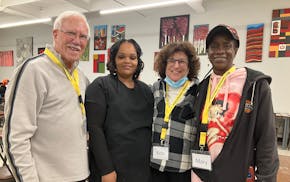On a sunny morning this past spring, a group of 25 curious souls met at Minnehaha Falls in Minneapolis. We were there to be led through darkness by a small, skeptical woman named Karen Cooper, who has been investigating the history of the place for more than 20 years, turning over rocks to see what crawls out.
The fruits of her labor have been collected in a book, "When Minnehaha Flowed With Whiskey: A Spirited History of the Falls," to be published by the Minnesota Historical Society Press. The book comes out in August, but if you want a preview, you can join one of Cooper's Raucous Ramble tours, hosted by the Hennepin History Museum. The next tour will be July 23.
Cooper has a deep knowledge of the place's history, gleaned from a mountain of material she's collected, including some 80 boxes of photos, documents and souvenirs. She's looked into many stories about the falls and found most of them wanting.
Like the Longfellow House, which is often described as a three-quarter replica of Henry Wadsworth Longfellow's House.
"It's not a replica," she says. "I've been to the original house, and measured it. It's just not!"
Cooper, a stickler for evidence, takes a certain glee in puncturing the myth that "The Song of Hiawatha" poem was inspired by an early photo of the falls that Longfellow saw. (Cooper's research points to another source of Longfellow's information: a relative of Longfellow's who had just returned from Minnesota.)
In short, she doesn't believe anything that she can't document. And she's found some very interesting documents.
For instance, a German "turner" who tightrope-walked across the falls in 1886. (She found the photo.) There are records of a man named Dutch Henry who ran a "blind pig" (an illegal saloon) at the falls. And there are reports of the owner of the Minnehaha Hotel who tried, euphemistically, to "minister to the inner man," suggesting that the aim was to satisfy baser instincts.
Instead of a postcard-perfect vision of the past, Cooper depicts Minnehaha Falls as a snapshot of the chaotic world of early America — a debauched free-for-all — and the strivers and opportunists and charlatans who, for better or worse, helped this famous cascade make Minnesota the place it is today.
5 things you didn't know about the Falls
- There was a Minnehaha Midway.
Private vendors of food and refreshments (legal and illegal) had taken up residence at the falls in the 1850s. When they were kicked out of the park in 1889, they set up shop just across the street, between Minnehaha and Hiawatha avenues. This strip became known as the "Minnehaha Midway," and it was a bawdy funhouse: There were refreshment pavilions, shooting galleries, a bowling alley, carnival games, photo booths, a merry-go-round, a Ferris wheel, souvenir stands, dance halls and illegal saloons. And while there's no sure evidence, there's some suggestion of prostitution taking place.
2. The early refectory fell to fire.
The building that now houses Sea Salt was not the first pavilion at the falls. The current structure was built in 1905. But one was also erected in 1903. It was a huge success, selling sandwiches, ice cream and refreshments from the soda fountain. The operators of the Minnehaha Midway were not pleased. On Oct. 27, 1904, at around 10 p.m., the first refectory mysteriously burned to the ground. Witnesses said kerosene had been sprinkled around. The culprit was never caught, but Cooper suspects Adelbert Gardner, the shady character who ran the Minnehaha Midway.
3. A poaching sergeant hosted "Deer and Beer" parties.
In the early 1900s, John O'Brien was the police sergeant in charge of Minnehaha Falls, and was notoriously corrupt. (He charged the Park Board $200 for "turning the water on and off.") In 1905, a scandal hit the papers when it was revealed that O'Brien had been shooting captive deer from the Minnehaha Falls Park zoo and hauling them over to the historic John H. Stevens House, where he hosted what he called "Deer and Beer" parties.
4. A sutler built a home there.
Franklin Steele was one of the first people to make a lot of money off the falls. He was the "sutler" (store owner) at Fort Snelling, and brother-in-law of future Gov. Henry Sibley. In the 1850s, Steele acquired all the land on the north side of the falls. He built a handsome house in the 1860s where the roundabout at Minnehaha Avenue and Godfrey Parkway is now. In 1902, that house was moved to 5028 Hiawatha Av., where it stands today as one of the oldest houses in Minneapolis.
5. The park lost 50 acres in a land grab.
The man Cooper calls the "criminally corrupt Doc Ames" was a four-time mayor of Minneapolis, who was guilty of many sins. But the worst one might have been theft of the 50 acres from Minnehaha Falls Park.
The city and state were in the process of carving out the park, the borders of which included Ard Godfrey's land, where the Minnesota Veterans Home now sits. Ames, looking to garner political support from Civil War veterans, decided that would be the best place for the Soldiers Home — which could have been located anywhere in Minnesota —even though he knew the home was supposed to be within the park borders.
With some deft maneuvering (and a financial shell game) he settled the matter, cutting off a chunk of parkland before the park's borders could be written into law.
If you go
Karen Cooper's Raucous Ramble tours will be held at Minnehaha Falls at 1 p.m. July 23, Aug. 6, Sept. 10 and Oct. 1. Register for the $10-$14 tours, sponsored by the Hennepin History Museum, here.
Frank Bures is a Minneapolis-based writer.

Minnesota veteran makes 1,000-mile 'gratitude walk' for program that helps vets

At 90, Minneapolis volunteer has lifetime of service

Betting on Uptown

